Mango ginger (inji mangai) Curcuma amadaa, plant of the ginger family Zingiberaceae, is made into a wonderful pickle on its own merit, and also in combination with Magali beru and gooseberry
Mango ginger (inji mangai) Curcuma amada
Did you know that Mango ginger (inji mangai) Curcuma amadaa, plant of the ginger family Zingiberaceae, is made into a wonderful pickle on its own merit, and also in combination with Magali beru and gooseberry?
Mango ginger, with the scientific name Curcuma amada, Amra Haridra in Sanskrit. and in Tamil usage 'inji mangai', is a plant of the ginger family Zingiberaceae whose rhizomes are very similar to common ginger. It is called: Ambarasini, Huli Arsin in Kannada; Aamaa-haldi, Amiyaa haldi in Hindi; Mamidi Allamu in Telugu; and Mankayyinji in Tamil. It is a popular spice and vegetable due to its rich flavor, which is described as sweet with subtle earthy floral and pepper overtones, and similar to that of raw mango have a distinct raw mango flavour.
Amra Haridra or Mango ginger, consists of the rhizome of Curcuma amada. It is a biennial plant with a pale-yellow hue with ovoid root stock, which grows upto 60 to 90 cm high. It is native to West Bengal, on the hills of west coast of India and now in fact throughout India. Also, commonly known as ' amahaldi ' is widely depicted in various ancient samhitas (scriptures) and text and used in the Indian system of medicine since time immemorial. As a perennial plant, it has Paripinnate oblong shaped leaves, bears unisexual pink flowers, flowering throughout the year, and bears fruits (Oblong pod with thinly septate, pilose, wrinkled) throughout the year. The plant is propagated with seeds and rhizome cuttings. P lants are adapted to grow in areas of seasonal drought in monsoonal forests.
Mango ginger's chemical components consist mostly of starch, phenolic acids, volatile oils, curcuminoids and terpenoids like difurocumenonol, amadannulen and amadaldehyde.
Mango ginger's biological activity has been variously described as "antioxidant, antibacterial, antifungal, anti-inflammatory, platelet aggregation inhibitory, cytotoxicity, antiallergic, hypotriglyceridemic, brine-shrimp lethal, enterokinase inhibitory, CNS depressant, and analgesic." It is commonly used in Ayurveda and Unani medicines as diuretic, laxative, expectorant, aphrodisiac and to provide relief from cold, cough and skin issues.
Ethanolic and water extracts, together with volatile oils from the rhizomes of Zingiberaceous plants, including Curcuma mangga, has shown an antiallergic effect while the volatile oil didn't have any effect on allergic symptoms.
Inji Mangai or Mango ginger is a culinary delight as a pickle, particularly in Southern India, due to its pleasant flavour, faint aroma and medicinal qualities. A popular recipe for this pickle is follows:
* Peel and chop into roots of Inji Mangai (fully in a dry form) into cubes
* Add salt, turmeric, red chilli powder, fenugreek and mustard powder and mix well
* Add fresh lime juice and seal the container
* Consume, after adding a tempering of mustard seeds with asafoetida.
- Narasipur Char







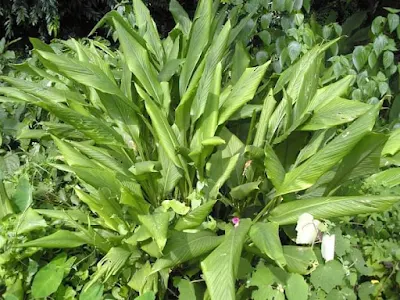
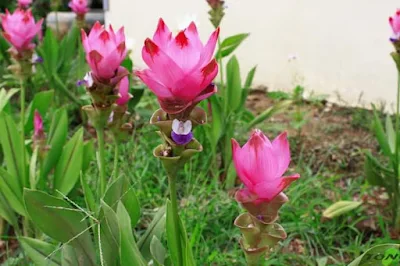
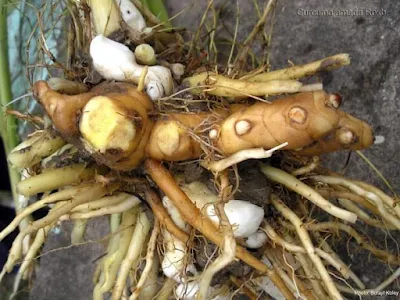
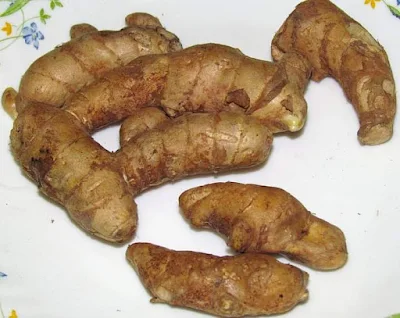
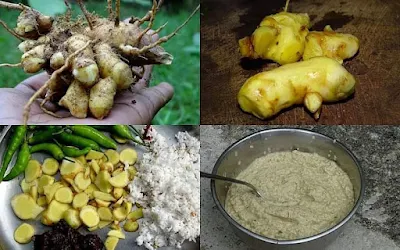
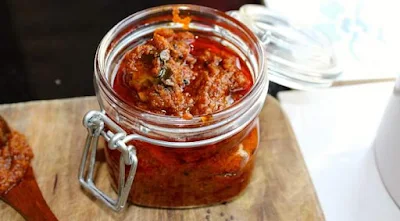










No comments:
Post a Comment